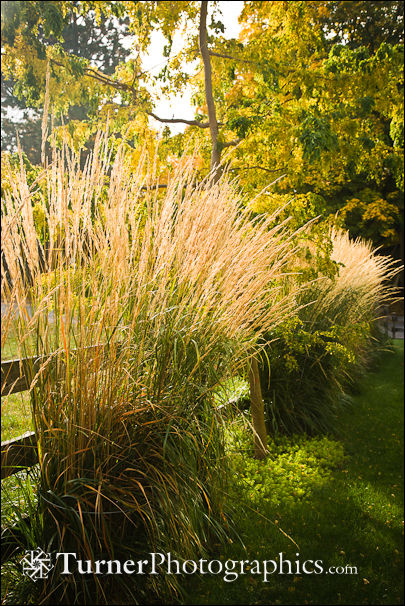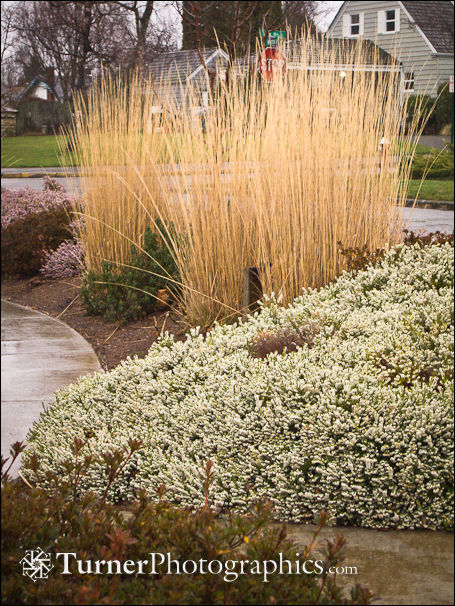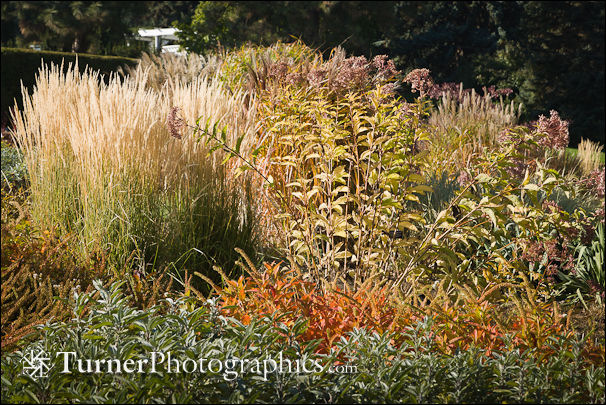Plant of the Month: ‘Karl Foerster’ Feather Reed Grass
Calamagrostis acutiflora ‘Karl Foerster’
Ornamental grasses come into their glory each autumn, shimmering in the golden rays of afternoon light, swaying in the gentlest breezes, and lending a strong vertical backdrop to soft drifts of colorful asters and sedums. One of the first tall grasses to bloom is ‘Karl Foerster’ Feather Reed Grass, Calamagrostis acutiflora ‘Karl Foerster’.

This standout grass, which was the 2001 Perennial Plant of the Year, forms gradually expanding clumps 3-4 feet tall. It tolerates a wide range of conditions from zones 3 to 9 and is happiest in full sun, in moist to wet fertile soil. It thrives in clay soil, but will grow in dry sandy soils as well. It has no serious pest nor disease problems. I’ve never seen it become invasive and the seeds are sterile so it won’t self-seed. That’s important because out-of-control grasses can quickly take over.
 As a tall, upright grass, ‘Karl Foerster’ is a good choice for the back of the border or against a fence. It begins to bloom in June or July, but achieves its rich golden color in September. The flowers remain into the winter on upright stems that are strong enough to stand up to most snowfall so it lends three-season structure to your garden.
As a tall, upright grass, ‘Karl Foerster’ is a good choice for the back of the border or against a fence. It begins to bloom in June or July, but achieves its rich golden color in September. The flowers remain into the winter on upright stems that are strong enough to stand up to most snowfall so it lends three-season structure to your garden.
Maintenance is easy – just cut it to the ground around February before new growth begins and give it a light feeding in the spring. When your clump gets too big divide it with a shovel in early spring. You can plant ‘Karl Foerster’ either in the fall, to take advantage of fall and winter rains, or in the spring.
 ‘Karl Foerster’ is widely planted and versatile. Just up the street from our house in Bellingham a church uses it in a border with heather to separate their passenger drop-off area from the public sidewalk. I photographed it in a Coeur d’Alene garden where its vertical lines intersect with the horizontal rails of a wooden fence. At Linden Gardens in Kaleden, south of Penticton in the Canadian Okanagan, it is one of several grasses that contrast with asters in wide perennial borders. At Manito Park in Spokane it complements the late summer foliage of Joe Pye Weed. Susan Caldwell, in Kelowna, British Columbia, uses it against a wooden fence with roses, asters, and coneflowers.
‘Karl Foerster’ is widely planted and versatile. Just up the street from our house in Bellingham a church uses it in a border with heather to separate their passenger drop-off area from the public sidewalk. I photographed it in a Coeur d’Alene garden where its vertical lines intersect with the horizontal rails of a wooden fence. At Linden Gardens in Kaleden, south of Penticton in the Canadian Okanagan, it is one of several grasses that contrast with asters in wide perennial borders. At Manito Park in Spokane it complements the late summer foliage of Joe Pye Weed. Susan Caldwell, in Kelowna, British Columbia, uses it against a wooden fence with roses, asters, and coneflowers.
Flower arrangers like ‘Karl Foerster’ too as it makes a good cut flower that provides vertical structure to floral displays just as it does outside in the garden.

Every garden needs plants with a variety of textures and heights. ‘Karl Foerster’ Feather Reed Grass is a good choice for a tall spiky thing at the back of the border with great autumn interest.


I fell in love with the ornamental grasses when they hit the gardening scene years ago. I love the textures they add to the landscape, and the fall stalks of flowers that persist into winter are spectacular!
Beautiful photographs. Would you happen to know the name of the bright purple plant/flower in the top image? I love it and can’t seem to figure out what it is.
They are Asters Holly :))
I just re-read your article more closely and saw that the flowers I asked about are probably asters. My question now is, what variety are they if you know? Thank you!
I’m betting this Aster is “Purple Dome”!
Holly, I don’t know the variety of aster in the top photo. The image is from Linden Gardens in Kaleden, British Columbia and the asters weren’t labeled.